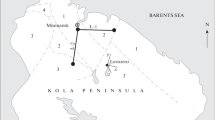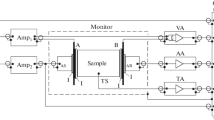Abstract
The results of synchronous observations of the electric field on the shallow crustal layers of the Earth’s crust and the microseismic vibrations are presented. On the basis of the coincidence of the statistics of the electric and microseismic pulses of the relaxation type, and, also, the fact that the indicated pulses accompany each other, the conclusion is reached about the unique source of both pulses. The constrained rotation of the structural block during its relaxation is considered as such a source. A mechanism is proposed for the generation of electromagnetic signals, connected with the separation of electric charges as a result of the rapid change in the stress-strain state of the rocks of a complex hierarchic-block structure. A model developed by the authors, for the generation of electromagnetic signals during the relaxation processes in the Earth’s crust of a heterogeneous structure, is presented.
Similar content being viewed by others
References
V. V. Adushkin and A. A. Spivak, “Microseismicity and Intensity of the Relaxation Processes in the Earth’s Crust,” Dokl. Akad. Nauk, 408(4), 532–534 (2006).
V. V. Adushkin, A. A. Spivak, S. B. Kishkina et al., “Dynamic Processes in the System of Interacting Geospheres at the Earth’s Crust-Atmosphere Boundary,” Izv. Ross. Akad. Nauk, Fiz. Zemli, No. 7, 34 (2006).
A. M. Budkov and S. P. Soloviev, “The Electric and Magnetic Field, Caused by the Electric Polarization of Rock during the Underground Explosion,” in Dynamics of Interacting Geospheres (Institute of Geosphere Dynamics, Russian Academy of Sciences, Moscow, 2004) pp. 112–119.
O. Yu. Dinariev, and V. N. Nikolaevskii, “The Electromagnetic Signals, Excited by the Deformation Waves in the Media with Microstructure,” Dokl. Akad. Nauk, 358(5), 627–629 (1998).
Ya. I. Frenkel, “To the Theory of Seismic and Seismoelectric Phenomena in Humid Soil,” Izv. Akad. Nauk SSSR, Ser. Geograf. i Geofiz., 8(4), 133–150 (1944).
I. A. Garagash, “The Model of Formation of Tectonomagnetic Effect in the Fault Zone in Shear,” Ross. Zhurnal Nauk o Zemle, No. 3, 1–11 (1999).
M. B. Gokhberg, V. A. Morgunov, and O. A. Pokhotelov, Seismic Electromagnetic Phenomena (Nauka, Moscow, 1988, pp. 1–174) [in Russian].
A. K. Goncharov and S. P. Soloviev, “The Shock Electric Polarization of Materials,” Fizika Goreniya i Vzryva, 40(6), 52–57 (2004).
E. M. Gorbunova, G. N. Ivanchenko, and A. A. Spivak, “Selection of the Object for Conducting of Comprehensive Studies of Geodynamic and Geophysical Anomalies in the Influence Zones of Tectonic Structures,” in Nonstationary Processes in the Upper and Lower Earth Mantle (Institute of Geosphere Dynamics, Russian Academy of Sciences, Moscow, 2002) pp. 114–129.
A. V. Guglielmi, “Excitation of the Electromagnetic Field Oscillations by the Elastic Waves in Conductive Body,” Geomagnetizm i Aeronomiya, 27(3), 467–470 (1986).
A. V. Guglielmi, “Problems of Physics of Geoelectromagnetic Waves,” Izv. Ross. Akad. Nauk, Fiz. Zemli, No. 3, 3–16 (2006).
A. V. Guglielmi and V. F. Ruban, “To the Theory of Induction Seismomagnetic Effect,” Izv. Akad. Nauk SSSR, Ser. Fizika Zemli, No. 5, 47–54 (1990).
G. N. Ivanchenko, “About the Classification of Fracture Dislocations of the Eastern European Platform with the Account of Fracture Forming Forces,” in Nonstationary Processes in the Upper and Lower Earth Mantle (Institute of Geosphere Dynamics, Russian Academy of Sciences, Moscow, 2002) pp. 86–94.
G. G. Kocharyan and A. A. Spivak, The Dynamics of Deformation of the Block Rock Massifs (Akademkniga, Moscow, 2003, pp. 1–423) [in Russian].
Kh. F. Makhmudov and V. S. Kuksenko, “Electromagnetic Phenomena Related to Deformation and Destruction of Solid Dielectrics,” Fizika Tverdogo Tela, 47(5), 856–859 (2005).
S. A. Maltsev and V. A. Morgunov, “To the Physical Model of the Disturbances of the Electrostatic Field of the Lithospheric Nature in the Atmosphere and Electromagnetic Pulse,” Izv. Ross. Akad. Nauk, Fiz. Zemli, No. 9, 65–73 (2005).
I. A. Molchanov and M. Haykawa, “Generation of ULF Electromagnetic Emission by Microfracturing,” Geophys. Res. Lett., 22(22), 3091–3094 (1995).
O. A. Molchanov and M. Haykawa, “On the Generation Mechanism of ULF Seismogenic Electromagnetic Emissions,” Phys. Earth and Planet. Inter., 105, 201–210(1998).
M. V. Rats, Heterogeneity of Rocks and their Physical Properties (Nauka, Moscow, 1968, pp. 1–107) [in Russian].
G. A. Sobolev and V. M. Demin, Mechanoelectrical Phenomena in the Earth (Nauka, Moscow, 1980, pp. 1–215) [in Russian].
S. P. Soloviev and A. A. Spivak, “Electromagnetic Effects during the Relaxation Processes in the Earth’s Crust of the Heterogeneous Structure,” Dokl. Akad. Nauk, 417(6), 823–827 (2007).
S. P. Soloviev and A. A. Spivak, “The Electromagnetic Effects as a Result of Heterogeneous Structure and Differential Motions in the Earth’s Crust,” in Dynamic Processes in the System of Internal and External Interacting Geospheres (GEOS, Moscow, 2006) pp. 196–204.
S. P. Soloviev, A. A. Spivak, and V. V. Surkov, “The Electromagnetic Field, Generated by Polarization of Rocks Related to Chemical Explosion,” in Physical Processes in the Geospheres: Their Manifestations and Interaction (Institute of Geosphere Dynamics, Russian Academy of Sciences, Moscow, 1999) pp. 152–158.
S. P. Soloviev and J. J. Sweeney, “Generation of Electric and Magnetic Field during Detonation of High Explosive Charges in Boreholes,” J. Geophys. Res., 110, B01312 (2005). doi:10.1029/2004JB003223.
A. A. Spivak and S. B. Kishkina, “Microseismic Background Study for Determination of Active Tectonic Structures and Geodynamic Characteristic of Medium,” Fizika Zemli, No. 7, 35–49 (2004).
V. V. Surkov, Electromagnetic Effects Accompanying Earthquakes and Explosions (Moscow Physical Engineering Institute, MIFI, Moscow, 2000) pp. 1–447.
Author information
Authors and Affiliations
Additional information
Original Russian Text © S.P. Soloviev, A.A. Spivak, 2009, published in Fizika Zemli, 2009, No. 4, pp. 76–84.
Rights and permissions
About this article
Cite this article
Soloviev, S.P., Spivak, A.A. Electromagnetic signals generated by the electric polarization during the constrained deformation of rocks. Izv., Phys. Solid Earth 45, 347–355 (2009). https://doi.org/10.1134/S1069351309040077
Received:
Published:
Issue Date:
DOI: https://doi.org/10.1134/S1069351309040077




